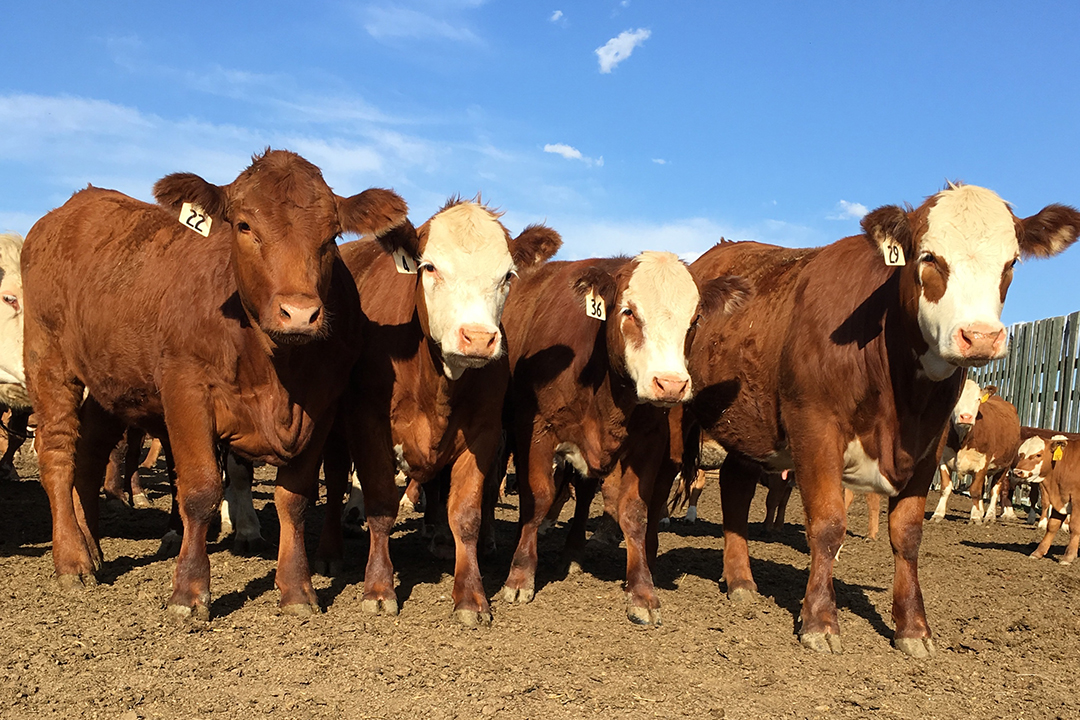
Is temperament linked to stress in beef cattle?
Understanding how cattle behaviour relates to productivity, immune status and welfare is a key research focus for Dr. Diego Moya, beef cattle ethologist at the Western College of Veterinary Medicine (WCVM).
By Paisley Johnson“The whole objective is to make the animals — even within the intensive industry that we are working with — feel better during their life span and reduce the incidence of disease and reduce stress,” explains Moya, an assistant professor in the WCVM’s Department of Large Animal Clinical Sciences.
“That’s the whole goal of the research that I do.”
The temperament of beef cattle plays a key role in how they respond to certain situations and the amount of stress they may experience during routine handling procedures.
Cattle with especially excitable temperaments become more aggravated and struggle more when they’re held in a chute for handling procedures such as vaccinations and weighing. These cattle are at more risk of causing injury to themselves, to other animals and to human handlers. They also tend to experience more stress during these procedures — a situation that decreases their welfare.
As beef cattle welfare becomes increasingly important for consumers and livestock producers alike, the temperament of individual animals is becoming more important in determining their quality of life.
One of Moya’s research goals is to further investigate the effects of temperament on the performance of beef cattle. In previous studies, researchers have found that cattle with more agitated or excitable temperaments have slower growth rates and poorer feed efficiencies than those with calmer temperaments.
By analyzing the feeding behaviour of cattle and how they interact with each other in a competitive setting, researchers have determined that some animals with dominant or aggressive temperaments may have more access to feed than more submissive animals — behaviour that affects the animals’ growth.
As part of this research project, Moya and his team are studying how cattle interact with one another in a smaller pen and identifying individual animals as dominant or subordinate during each interaction. The researchers are also observing the social interactions of cattle to draw further insight into the temperament of each animal and how they act in a group setting when introduced to new penmates.
Another aspect of this particular study is to examine the effects of stress-responsiveness on immune status of individual cows. Cortisol is a hormone that’s released when an animal is presented with a stressor, and it has a number of physiological effects that help the animal to cope with a stressor. By using cortisol as a biomarker of stress, it’s possible to study the role of animal stress on the immune system and its potential for causing the animal to become more susceptible to pathogens and disease.
“The idea will be for the producers and the industry to better identify those susceptible animals and therefore improve their management and improve treatment and drug efficiency when they are sick,” says Moya.
As part of the study, Moya performed ACTH (adrenocorticotropic hormone) challenges on the cattle, a test that allows researchers to individually measure the release of cortisol in a controlled scenario. Once he and his team analyze this data, they will be able to determine if the cattle with more excitable temperaments also have more exacerbated stress responses to certain stimuli. The researchers will also examine each cow’s blood parameters to determine if the immune system of the more excitable animals is compromised in any way compared to the calm animals.
The research team also conducted several behaviour tests with the goal of characterizing the temperament of cattle. These tests included flight speed, which measures how quickly each cow exits the chute, and chute behaviour to quantify how much they struggle while being restrained. As well researchers performed an open-field test to help them to measure the animals’ explorative and social temperaments.
The team also conducted a novel object test that’s designed to measure the animals’ neophobic temperament as well as a human reactivity test that helps to measure the cows’ flight zone. During this particular test, a person directly approaches each cow while the animal is restrained in a chute.
The WCVM researchers’ investigation is one of many studies that will help producers and veterinarians learn how the behaviour, productivity and welfare of beef cattle are all connected.
Paisley Johnson is a fourth-year animal bioscience student in the U of S College of Agriculture and Bioresources. Her story is part of a series of articles written by WCVM summer research students.